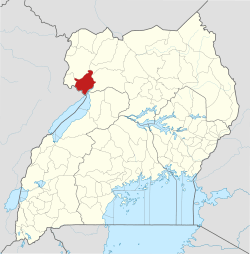Nebbi District
Nebbi District is a district in Northern Uganda. It is named after its main municipal, commercial and administrative centre, Nebbi, the location of the district headquarters.
Nebbi District | |
|---|---|
 District location in Uganda | |
| Coordinates: 02°27′N 31°15′E | |
| Country | |
| Region | Northern Uganda |
| Sub-region | West Nile sub-region |
| Capital | Nebbi |
| Area | |
| • Total | 1,953.2 km2 (754.1 sq mi) |
| Population (2012 Estimate) | |
| • Total | 346,200 |
| • Density | 177.2/km2 (459/sq mi) |
| Time zone | UTC+3 (EAT) |
| Website | www |
Location
Nebbi District is bordered by Arua District to the north, Pakwach District to the east, Democratic Republic of the Congo (DRC) to the south and Zombo District to the west.[1] Nebbi, where the district headquarters are located approximately 77 kilometres (48 mi), by road, southeast of Arua, the largest town in the sub-region.[2] The coordinates of the district are:02 27N, 31 15E (Latitude:2.4500; Longitude:31.2500).
Overview
The district has one county (Padyere). In 2010, Okoro County was split off Nebbi District to form Zombo District and in 2017,(Jonam) which was one of the counties that made up Nebbi was split off to form Pakwach District. There is a small airstrip near Nebbi which can be reached using commercial flights from Entebbe Airport. A railway link which has not run for many years used to link the district to the rest of the Uganda Railway system.
There is a Catholic cathedral in Nebbi, and the Anglican diocese is based in Goli, a town situated at the border with the Democratic Republic of the Congo, about 15 kilometres (9.3 mi), by road south of Nebbi. The first bishop of the Anglican diocese of Nebbi was Henry Luke Orombi, who is the immediate past archbishop of the Church of Uganda. The first bishop of Nebbi Catholic diocese was John Baptist Odama. He is currently the archbishop of the Roman Catholic Archdiocese of Gulu.
Population
In 1991, the national population census estimated the district population at about 185,550. The 2002 national census estimated the population of the district at approximately 226,310. The annual population growth rate of the district was calculated at 2.7%. In 2012, it was estimated that the population of Nebbi District was about 346,200.[3] The table below illustrates the growth of the district population between 2002 and 2012. All figures are estimates.
|
|
|
Ethnicities
The predominant ethnicity in the district are the Alur, with the languages spoken being Alur and Jonam.
Economic activities
Agriculture (crop agriculture and animal husbandry), together with fishing are the main economic activities in the district. Crops grown include:[4]
Fishing on Lake Albert and in the Albert Nile is practiced widely for subsistence and commercial purposes. Common species of fish include Nile Perch (Lates Niloticus) and Tilapia (Oreochromis Niloticus). Local rivers in the district, such as the Nyagak and Namrwodho Rivers, also afford fishing opportunities to those far removed from Lake Albert and the Nile River.
References
- Uganda District Map
- "Road Distance Between Arua And Nebbi With Map". Globefeed.com. Retrieved 22 May 2014.
- "Estimated Population of Nebbi District In 1991, 2002 & 2012". Citypopulation.de. Retrieved 22 May 2014.
- "Economic Activity In Nebbi District". Uganda Travel Guide. Retrieved 22 May 2014.